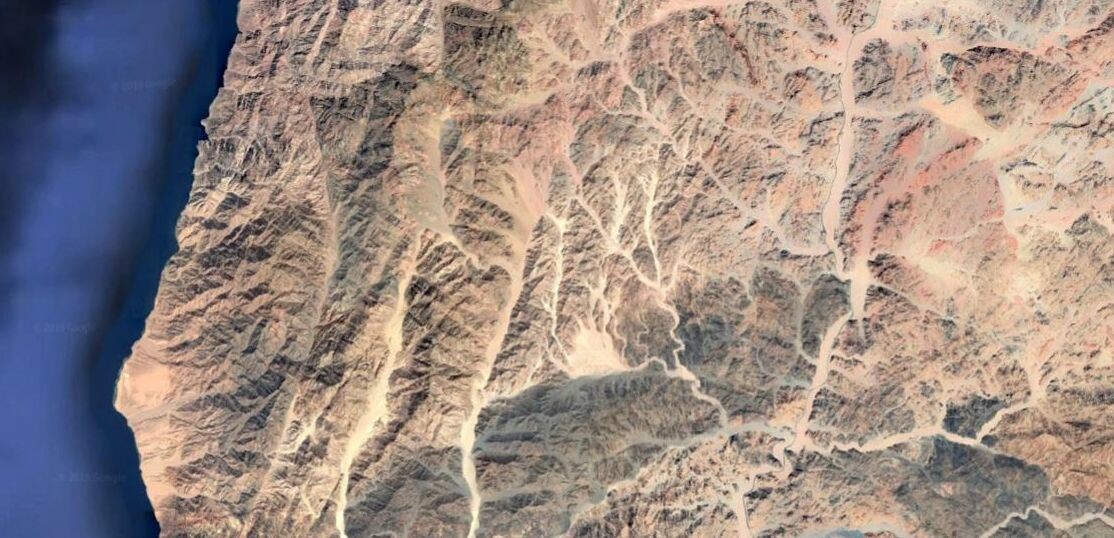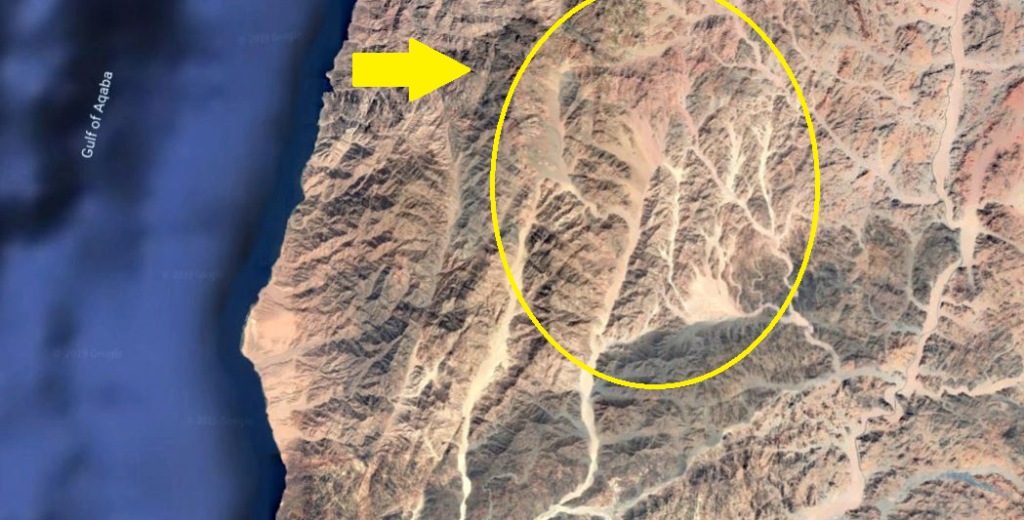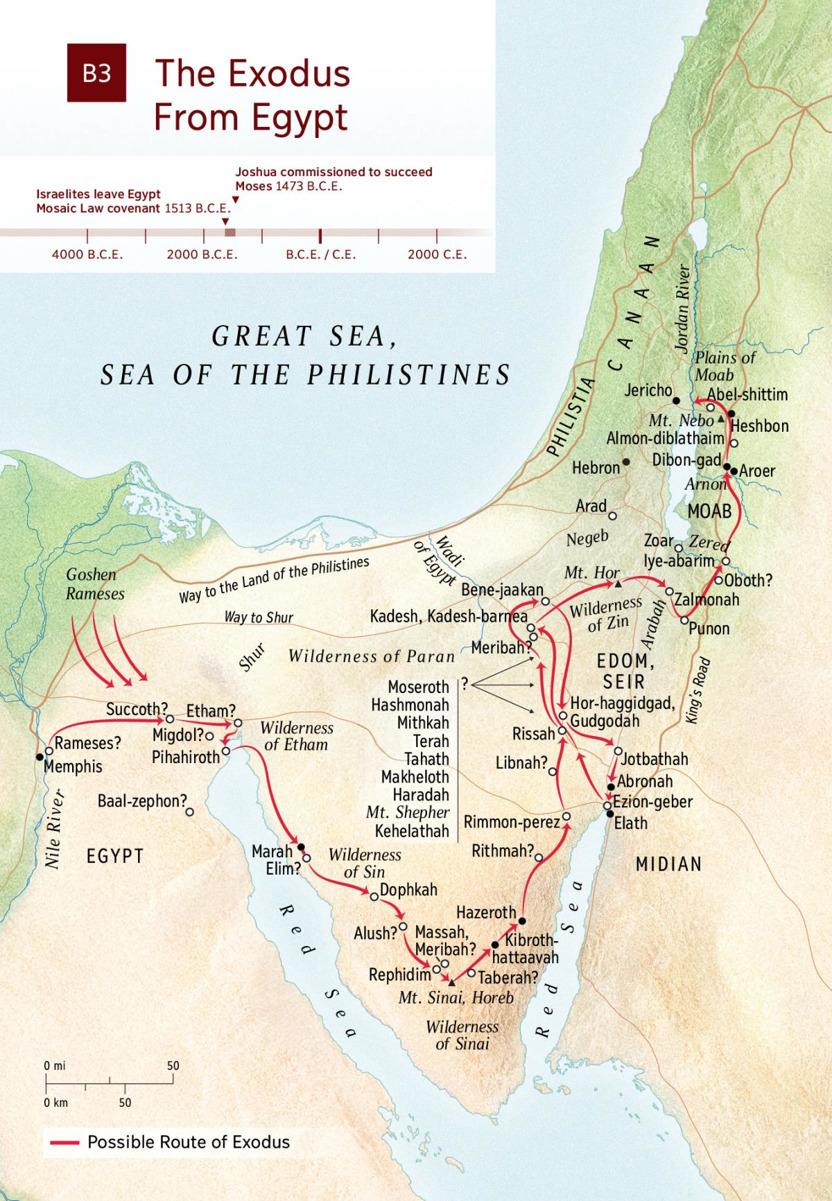The Bitter Spring of Marah

According to Exodus 15, after crossing the Red Sea and escaping Pharaoh's army, the Hebrews traveled through the wilderness of Shur and came to a place with a bitter spring they called Marah.
Moses and the Hebrews had been traveling through the desert for three days and were destitute of water. They complained to Moses about their thirst, again wishing they had stayed in Egypt where they had plenty of water.
They came to a spring, but found that the water was bitter and undrinkable. They named this location Marah, which translates as "bitter." With no water to drink, the Hebrews complained about their predicament.
Moses brought their complaints to God, who then showed Moses a log nearby. He instructed Moses to throw the log into the bitter waters. Upon thrusting the log into water, it became sweet and drinkable.
There the Lord made for them a statute and a rule, and there he tested them, saying, “If you will diligently listen to the voice of the Lord your God, and do that which is right in his eyes, and give ear to his commandments and keep all his statutes, I will put none of the diseases on you that I put on the Egyptians, for I am the Lord, your healer.” - Exodus 15:25-26
The bitter spring of Marah was one of the first stops after Moses and the Hebrews crossed the Red Sea. After God made the water drinkable, they drew from the spring and then moved on to the oasis at Elim. Locating Marah's exact position is a somewhat difficult challenge. We do have at least some frame of reference, though.
If Mount Sinai is in Saudi Arabia, as we contend, this means that Marah has to be in Saudi Arabia as well.
Dr. Colin Humphreys, author of The Miracles of Exodus: A Scientist's Discovery of the Extraordinary Natural Causes of the Biblical Stories, also contends that Marah is in northwestern Saudi Arabia.
Humphreys asserts that there is a spring near the Caves of Jethro just outside al-Bad. British explorer St. John Philby also found this spring during his travels and wrote about it in his 1957 book The Land of Midian.
The tiny oasis of al Maliha...lay about 1000 yards from the Mughayir [the caves of Jethro]... In the oasis were a number of wells, about 3 1/2 fathoms in depth, with water so sweet that it is compared in local estimation with the Nile. Hence its name [al Maliha], meaning "the salt well," on the lucus a non lucendo principle.
St. John Philby, The Land of Midian, 1957. (Quoted in Colin Humphreys, The Miracles of Exodus: A Scientist's Discovery of the Extraordinary Natural Causes of the Biblical Stories, (New York: HarperCollins, 2003), 269.)
A lucus a non lucendo is a way of saying this is a contradiction. In Latin, the phrase roughly translates to "the grove does not shine." In a shady grove, there is little sunshine because of the tree branches blocking the sun's light.
The name of this spot is a contradiction because the water is reportedly sweet, but the name of the well, al-Mahila, means "salt well." That hardly makes sense.
Dr. Humphreys suggests that the water, if this is Marah, may naturally be clear and sweet, but that a recent storm could have caused pollutants and surface-level minerals to contaminate the well's waters. (He also contends that the Red Sea was parted due to a massive storm, and the timing of the storm would have lined up with a contaminated well, in his assessment).
As for the purification of the water, Dr. Humphreys asserts that the piece of wood that Moses threw into the spring may have been charred Acacia seyel wood. Charcoal has been used across many civilizations to purify water, and even simply by putting some charcoal into the water, and allowing the coal's porous surface to absorb the minerals and other contaminants in Marah's bitter spring.
Determining Marah's Location
We believe that Marah is located a short distance northwest of Elim. This oasis, just a short distance from the Gulf of Aqaba in Saudi Arabia, was the stop right after the Israelites stopped at Marah.
As of now, we do not have an exact location, but we are fairly sure of the general area. See the map below for our approximate location.

In the area outlined above, there are reportedly several springs. Jim and Penny Caldwell, who lived in this region during the 1990s, told the Doubting Thomas Research Foundation that they found a spot they believe is Marah, but we have not yet had the opportunity to thoroughly search this area for the most fitting candidate.
The Biblical account, specifically Numbers 33, indicates that the bitter spring of Marah must very close to Elim, perhaps within a day's travel. From our approximate location for Marah to Elim, the journey would be about 10-12 miles. However, Marah may actually be somewhat closer or farther; our future investigation into this site will offer answers.
In chapter 58 of his 2003 book The Exodus Case, Dr. Lennart Möller claims that on local maps, there is a location marked "Ain Marra" near the ancient city of Midian and Jabal al-Lawz. In Arabic, "Ain" means spring, so Ain Marra could mean "bitter spring."
We plan future trips to Saudi Arabia to explore this area and look for sites that could be where Moses and the Hebrews stopped on their way to Mount Sinai. Check back with us soon to see our latest discoveries!
As a 501(c)(3) non-profit, we rely upon our donors to fund our research and day-to-day operations. To help us find the answers about the bitter spring of Marah, please consider making a contribution. A donation of any amount makes a difference. Thank you for your support!
Alternative Sites
Since there are alternative sites proposed to be Mount Sinai, there are also alternative sites for Marah as well. Most modern Bibles place Mount Sinai at the traditional location, St. Catherine's mountain in the southern Sinai Peninsula. Their identification of Marah will subsequently, as a result, look something like this:

Some maps are a bit more detailed, such as the one below.

These identifications for Marah largely rest on the presumption that Mount Sinai must be located in Egypt's Sinai Peninsula. However, if the mountain is located elsewhere, such as modern-day Saudi Arabia, Marah likely could not be in Egypt.
One notable exception to this is Rabbi Alexander Hool, author of Searching for Sinai: The Location of Revelation. Based on his study of rabbinic sources, he believes that Marah was at the Great Bitter Lake. From here, he believes that the Israelites crossed the mid-Sinai Peninsula to the northern end of the Gulf of Aqaba and that Elim was in this vicinity.
We detail on our page about the Suez Crossing theory why we disagree with this assertion, and we subsequently disagree with this identification for Marah as well.
Last updated August 21, 2019.

Dear researchers,
One comment in regard to the identification of the biblical MARAH:
MARAH (Heb. “bitter”) = MALHA / MALIHA in Arabic:
“The tiny oasis of al-Maliha … lay about 1000 yards from the Mughayir [Jethro’s Caves) … In the oasis were a number of wells, about 3½ fathoms in depth, with water so sweet that it is compared in local estimation with the Nile. Hence its name [al-Maliha], meaning ‘the salt well’ on the lucus a non lucendo principle.” (John Philby, The Land of Midian, London: Ernest Benn Limited, 1957, p. 212)
Musil (1926) also mentions al-Malha [al-Maliha] as belonging to Al Bad and includes a photo of a rain-pool in al-Malha (Alois Musil, The Northern Hegaz. American Geographical Society, p. 119 –120)
“Al-Malha” was a well system in Moses’ hometown Madyan [Al Bad], and I would propose that this is the place he led the people to after the crossing. Moses would have known the shortest way through the mountains (the wilderness of Etham), and he knew that the water was perfect in MALHA and that it was the nearest source of freshwater (it was the same place where he had once helped Zipporah watering Jethro’s flocks).
Why was the water suddenly bitter / salty? A logical explanation would be the cataclysmic event of crossing Yam Suph three days earlier, an event which was accompanied by rainstorm, thunder, lightning, and an earthquake as per Scripture. I don’t think it’s a far stretch to assume that such violent storm had also affected nearby regions such as the valley of Madyan (some 50 miles away). The torrential rain would have washed mineral salts down from the cliffs into the valley, causing the water in the springs to become salty, bitter, and undrinkable.
I don’t think this proposition is invalidated by the fact that Jethro met Moses only at Mt. Sinai, when he took his family to him (and thus arguing that Moses did not come through Jethro’s town). If two million people had come through Al Bad in order to drink, how likely is it that Moses had the time or the occasion to say “Hello!” to his father-in-law and tell him about all the Lord had done for him? We simply don’t know that, but it shouldn’t surprise us if Moses didn’t have the time to meet up with Jethro (or maybe Jethro was asleep). Also, even if Moses had met up with his family, why should Zipporah and the kids drop everything and then join the crowd? Moses would have surely told them, “I have to lead these people for a few more days until we reach the Mountain of God, and then we will all come together again.”
In fact, the Hebrews would have passed a second time through Madyan [Al Bad] on their way to Mt. Sinai, and would smite Amalek a few miles further on. But why would a trained ‘military general’ like Moses leave his troops to kiss Zipporah goodbye or have a cup of tea with Jethro? Moses was kind of busy and a bit later Jethro would hear of Moses’ victory over Amalek. I am simply doing a bit of story-telling to show that Jethro’s later appearance at Mt. Sinai does in no way prove that Moses had not come through Al Bad earlier (in order to find water for his people at MALHA = MARAH).
I had a look at the location of “Ain Marra” which Lennart M. suggested, but this is way too far towards Jabal Al Lawz IMO – it wouldn’t have made sense at all to go there (and as far as I know there is no water there; it’s just the name which sounds similar).
The above is just for your consideration; needless to say that I may be wrong.
I have an old of Al Bad which shows the tiny oasis of MALHA / MARAH; I will gladly send it to you.
Best wishes
Jake